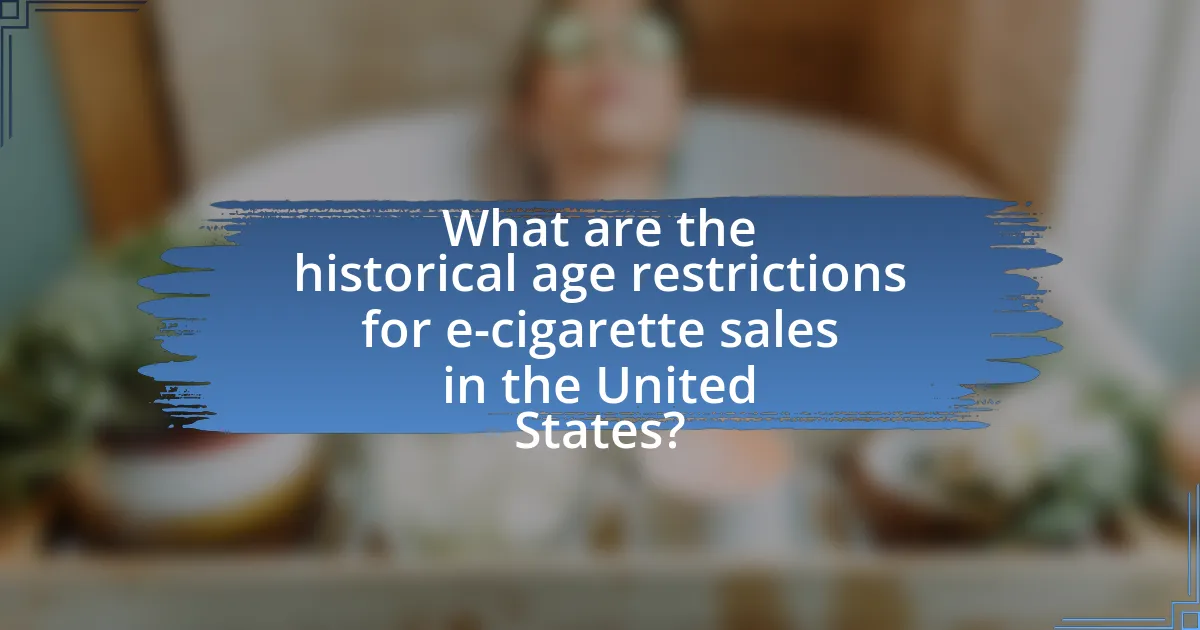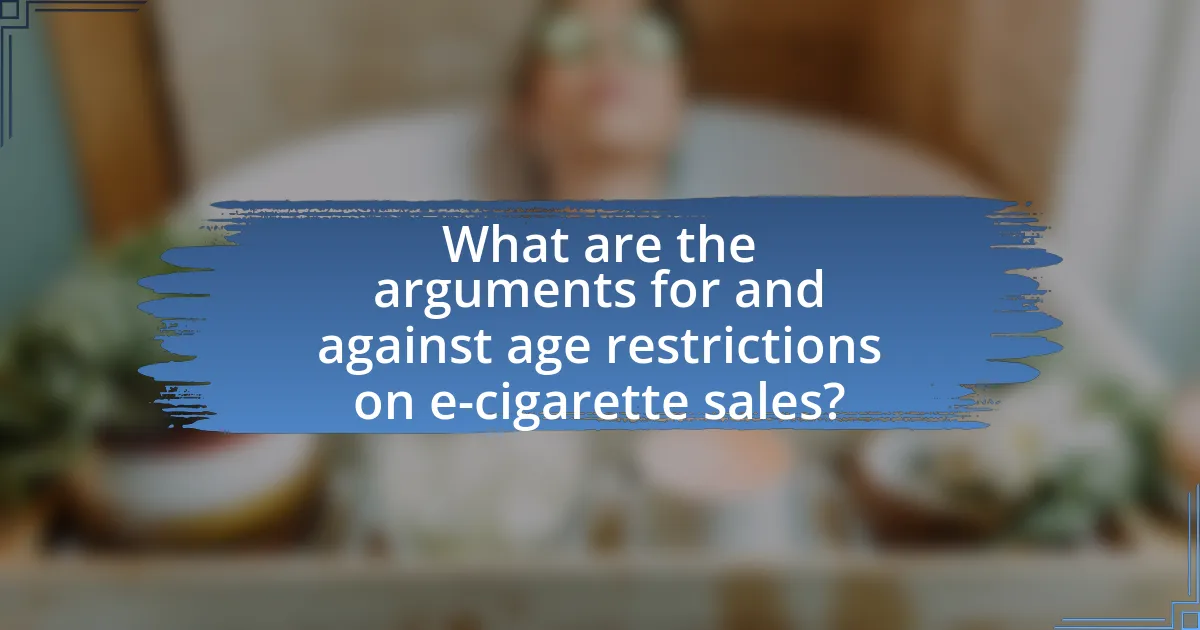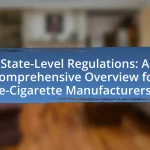The article examines the evolution of age restrictions for e-cigarette sales in the United States, highlighting the shift from a minimum purchasing age of 18 to 21 following the federal Tobacco 21 law enacted in December 2019. It discusses the historical context of tobacco regulations, the role of state governments in enforcing these laws, and the impact of public health campaigns on youth vaping rates. Additionally, the article explores the differences between state and federal regulations, the factors influencing state-level decisions, and emerging trends in e-cigarette regulation, including stricter marketing controls and the use of data to inform policy changes. The implications of these age restrictions on youth health and the ongoing debate surrounding their effectiveness are also addressed.

What are the historical age restrictions for e-cigarette sales in the United States?
The historical age restrictions for e-cigarette sales in the United States have evolved significantly over time. Initially, many states set the minimum age for purchasing e-cigarettes at 18 years, reflecting the age restrictions for traditional tobacco products. However, in December 2019, the federal government raised the minimum age for purchasing all tobacco products, including e-cigarettes, to 21 years through the Tobacco 21 law. This change was implemented to reduce youth access to nicotine products and has been adopted by most states, aligning state laws with federal regulations. Prior to this federal change, some states and localities had already enacted their own laws raising the minimum age to 21, indicating a trend towards stricter regulations aimed at protecting public health.
How have age restrictions evolved over the years?
Age restrictions for e-cigarette sales have evolved significantly over the years, primarily shifting from a patchwork of state regulations to a more standardized federal approach. Initially, many states set the minimum age for purchasing e-cigarettes at 18, but this varied widely, with some states allowing sales to individuals as young as 16. In December 2019, the federal government enacted legislation raising the minimum age for tobacco products, including e-cigarettes, to 21 nationwide. This change was influenced by growing concerns over youth vaping rates, which had surged from 1.5% in 2011 to 27.5% in 2019 among high school students, according to the National Youth Tobacco Survey. The evolution reflects a broader public health initiative aimed at reducing nicotine addiction among minors and standardizing regulations across states.
What were the initial age restrictions for tobacco products?
The initial age restrictions for tobacco products in the United States were set at 18 years old. This regulation was established in the 1960s when many states began to implement laws prohibiting the sale of tobacco to individuals under this age. By 1992, the federal government also recommended raising the minimum age to 21, but it was not until the Tobacco Control Act of 2009 that the age was officially raised to 21 nationwide, reflecting a significant shift in public health policy regarding tobacco use.
How did the introduction of e-cigarettes change these restrictions?
The introduction of e-cigarettes led to the implementation of stricter age restrictions for their sales in many states. As e-cigarettes gained popularity, concerns about youth access and health implications prompted lawmakers to raise the minimum purchasing age from 18 to 21 in several jurisdictions. For instance, the federal Tobacco 21 law enacted in December 2019 mandated that all states enforce a minimum age of 21 for the sale of tobacco products, including e-cigarettes. This legislative shift aimed to reduce underage vaping and align e-cigarette regulations with those of traditional tobacco products, reflecting growing public health concerns.
What role do state governments play in regulating e-cigarette sales?
State governments play a crucial role in regulating e-cigarette sales by establishing age restrictions, licensing requirements, and taxation policies. Each state has the authority to set its own legal age for purchasing e-cigarettes, which has evolved significantly; for example, many states have raised the minimum age to 21, aligning with federal regulations implemented in 2019. Additionally, state governments enforce regulations on the marketing and distribution of e-cigarettes, often requiring retailers to obtain licenses and adhere to specific health and safety standards. These regulations are supported by public health data indicating that stricter controls can reduce youth access to vaping products, thereby addressing concerns about rising e-cigarette use among adolescents.
How do state laws differ from federal regulations?
State laws differ from federal regulations in that they can establish more stringent requirements and restrictions tailored to local needs. For example, while federal law sets the minimum legal age for purchasing e-cigarettes at 21, some states have enacted laws that impose additional restrictions, such as limiting the sale of flavored e-cigarettes or requiring specific licensing for retailers. This variation allows states to address public health concerns and community standards more effectively, reflecting the diverse attitudes toward e-cigarette use across the country.
What factors influence state-level decisions on age restrictions?
State-level decisions on age restrictions are influenced by public health concerns, legal frameworks, and social attitudes. Public health data indicating the risks of e-cigarette use among youth drives policymakers to implement stricter age limits. Legal frameworks, including state constitutions and federal regulations, also shape these decisions by establishing minimum age requirements. Additionally, social attitudes towards smoking and vaping, often reflected in community advocacy and lobbying efforts, can significantly impact legislative outcomes. For instance, states with higher rates of youth vaping may respond with more stringent age restrictions to mitigate health risks.
What are the current age restrictions for e-cigarette sales across different states?
The current age restriction for e-cigarette sales across different states is primarily set at 21 years old, following the federal law enacted in December 2019 that raised the minimum age for purchasing tobacco products, including e-cigarettes, from 18 to 21. Most states have adopted this federal standard; however, a few states and local jurisdictions may have specific regulations that differ slightly. For instance, some states may have additional restrictions or enforcement measures, but the predominant age limit remains 21 years. This information is supported by the Tobacco Control Act and various state legislation updates.
Which states have the highest age restrictions for e-cigarette sales?
Hawaii and California have the highest age restrictions for e-cigarette sales, setting the minimum age at 21 years. This regulation aligns with broader tobacco control measures aimed at reducing youth access to nicotine products. In Hawaii, the law was enacted in 2016, while California implemented its age restriction in 2016 as well, reflecting a growing trend among states to raise the legal age for tobacco and vaping products to combat health risks associated with early nicotine exposure.
How do age restrictions vary between states with similar demographics?
Age restrictions for e-cigarette sales can differ significantly between states with similar demographics, primarily due to variations in state legislation and public health policies. For instance, while many states have set the minimum legal age for purchasing e-cigarettes at 21, some states with comparable populations, such as Florida and Texas, have enacted different laws; Florida allows individuals aged 18 to purchase e-cigarettes, whereas Texas has aligned with the federal standard of 21. This discrepancy illustrates how local governance and health advocacy efforts can influence age restrictions, even among states that share demographic characteristics. Additionally, states like California have implemented stricter regulations, including flavor bans, which further complicates the landscape of age restrictions and reflects differing public health priorities.
How do public health campaigns impact age restrictions for e-cigarette sales?
Public health campaigns significantly influence age restrictions for e-cigarette sales by raising awareness about the health risks associated with vaping among youth. These campaigns often lead to increased public support for stricter regulations, prompting lawmakers to implement age restrictions. For instance, after campaigns highlighting the dangers of e-cigarette use among adolescents, several states, including California and Massachusetts, enacted laws raising the minimum age for e-cigarette purchases to 21. Research indicates that states with active public health campaigns report a decrease in e-cigarette use among minors, reinforcing the effectiveness of these initiatives in shaping policy and protecting youth health.
What are the implications of age restrictions on youth vaping rates?
Age restrictions on e-cigarette sales significantly reduce youth vaping rates. Research indicates that states implementing stricter age limits, such as raising the minimum purchase age to 21, have seen a notable decline in vaping among adolescents. For instance, a study published in the Journal of Adolescent Health found that states with age restrictions experienced a 25% decrease in vaping prevalence among high school students within two years of enforcement. This correlation suggests that age restrictions effectively limit access to e-cigarettes, thereby decreasing usage rates among youth.

What are the arguments for and against age restrictions on e-cigarette sales?
Arguments for age restrictions on e-cigarette sales include the protection of youth from nicotine addiction and the potential long-term health risks associated with vaping. Research indicates that early exposure to nicotine can lead to increased likelihood of developing addiction to other substances, as highlighted in a study published in the journal Tobacco Control, which found that adolescents who use e-cigarettes are more likely to transition to traditional cigarettes.
Conversely, arguments against age restrictions often cite personal freedom and the belief that responsible adults should have the right to make their own choices regarding e-cigarette use. Critics argue that age restrictions may not effectively prevent underage access, as evidenced by surveys indicating that many minors obtain e-cigarettes through older peers or family members. Additionally, some argue that such restrictions could drive the market underground, making it harder to regulate product safety and quality.
Why do some advocate for stricter age restrictions?
Some advocate for stricter age restrictions on e-cigarette sales to protect youth from the potential health risks associated with vaping. Research indicates that nicotine exposure during adolescence can harm brain development, leading to long-term cognitive and behavioral issues. For instance, a study published in the journal “Tobacco Control” found that adolescents who use e-cigarettes are more likely to transition to traditional cigarette smoking, highlighting the need for regulations that limit access to these products for minors.
What health concerns are associated with youth access to e-cigarettes?
Youth access to e-cigarettes is associated with several significant health concerns, including nicotine addiction, respiratory issues, and potential long-term cognitive effects. Nicotine exposure during adolescence can lead to addiction and may increase the likelihood of using traditional cigarettes later in life. Research indicates that e-cigarette use among youth is linked to respiratory problems, as inhaling vapor can irritate the lungs and airways. Additionally, studies suggest that nicotine can adversely affect brain development, potentially impairing attention, learning, and susceptibility to mood disorders. These health risks underscore the importance of regulating youth access to e-cigarettes to protect their well-being.
How do proponents argue that age restrictions can reduce vaping among minors?
Proponents argue that age restrictions can reduce vaping among minors by limiting access to e-cigarettes, thereby decreasing the likelihood of initiation among youth. Research indicates that states with stricter age limits on tobacco and vaping products have seen a significant decline in usage rates among adolescents. For example, a study published in the Journal of Adolescent Health found that raising the minimum legal age for purchasing tobacco products to 21 resulted in a 25% reduction in vaping among high school students. This evidence supports the assertion that age restrictions effectively deter minors from engaging in vaping behaviors.
What are the counterarguments against strict age restrictions?
Counterarguments against strict age restrictions on e-cigarette sales include the assertion that such regulations may not effectively deter youth usage and could lead to unintended consequences. Research indicates that youth often find ways to circumvent age restrictions, such as purchasing from older peers or through online platforms that do not verify age adequately. Additionally, strict age limits may push young users towards more dangerous alternatives, such as illicit substances, rather than reducing overall consumption. A study published in the journal Tobacco Control found that overly restrictive policies can create a perception of e-cigarettes as more appealing due to their forbidden status, potentially increasing their allure among adolescents. Furthermore, critics argue that education and harm reduction strategies may be more effective than age restrictions in addressing youth vaping.
How do opponents argue that age restrictions may not be effective?
Opponents argue that age restrictions may not be effective because they believe that such regulations do not prevent underage individuals from accessing e-cigarettes. Research indicates that minors often obtain these products through older peers or family members, undermining the intended purpose of age restrictions. For example, a study published in the Journal of Adolescent Health found that 60% of underage e-cigarette users reported getting their products from someone older, highlighting the loopholes in enforcement and accessibility. Additionally, opponents contend that age restrictions may inadvertently create a sense of rebellion among youth, making e-cigarettes more appealing.
What alternative measures do critics suggest for addressing youth vaping?
Critics suggest several alternative measures for addressing youth vaping, including implementing stricter regulations on e-cigarette marketing, enhancing educational programs about the risks of vaping, and increasing taxes on vaping products. Stricter marketing regulations aim to limit the appeal of e-cigarettes to minors by prohibiting advertisements that target youth. Educational programs can inform young people about the health risks associated with vaping, potentially reducing usage rates. Additionally, higher taxes on vaping products can make them less affordable for young consumers, thereby decreasing access. These measures are supported by research indicating that comprehensive approaches can effectively reduce youth vaping rates.

What trends are emerging in the regulation of e-cigarette sales?
Emerging trends in the regulation of e-cigarette sales include increasing age restrictions and stricter marketing regulations. Many states are raising the minimum legal age for purchasing e-cigarettes to 21, aligning with tobacco regulations. For instance, as of 2021, over 30 states have implemented this age limit, reflecting a nationwide effort to curb youth access to vaping products. Additionally, regulations are tightening around advertising, with several states prohibiting e-cigarette promotions that target minors, thereby addressing public health concerns related to youth vaping. These trends indicate a significant shift towards more stringent oversight of e-cigarette sales to protect younger populations.
How are states adapting their laws in response to changing public opinion?
States are adapting their laws regarding e-cigarette sales by raising the legal age for purchase in response to changing public opinion that increasingly favors stricter regulations. For instance, many states have moved to increase the minimum age for purchasing e-cigarettes from 18 to 21, reflecting a growing consensus that younger individuals should have limited access to vaping products due to health concerns. This shift is supported by surveys indicating that a significant majority of the public believes in implementing stricter age restrictions to protect youth from potential addiction and health risks associated with vaping.
What recent legislative changes have been made regarding e-cigarette sales?
Recent legislative changes regarding e-cigarette sales include the implementation of age restrictions that raise the minimum purchasing age to 21 in several states. For instance, as of 2023, states like California, New York, and Illinois have enacted laws that prohibit the sale of e-cigarettes to individuals under 21 years old. This shift aims to reduce youth access to vaping products and aligns with federal regulations established by the Tobacco Control Act, which also set the minimum age for tobacco products at 21. These legislative measures reflect growing concerns about the health impacts of e-cigarettes on young people and the need for stricter controls on their availability.
How are states using data to inform their age restriction policies?
States are utilizing data analytics to shape their age restriction policies for e-cigarette sales by examining trends in youth usage and health outcomes. For instance, states like California and New York have analyzed data from the Youth Risk Behavior Surveillance System, which indicates rising e-cigarette use among adolescents, prompting them to raise the minimum legal age for purchase to 21. Additionally, states are leveraging public health data to assess the impact of these policies on youth smoking rates, demonstrating that stricter age restrictions correlate with decreased usage among minors. This data-driven approach ensures that policies are responsive to the evolving landscape of e-cigarette consumption and its associated health risks.
What future changes can we expect in age restrictions for e-cigarette sales?
Future changes in age restrictions for e-cigarette sales are likely to include an increase in the minimum purchasing age to 21 across more states. This trend follows the federal law enacted in December 2019, which raised the minimum age for purchasing tobacco products, including e-cigarettes, to 21. As public health concerns regarding youth vaping continue to grow, more states may adopt similar regulations to align with this federal standard, aiming to reduce access among minors and curb rising usage rates among adolescents.
How might federal regulations influence state laws moving forward?
Federal regulations can significantly influence state laws by establishing baseline standards that states must adhere to, particularly in areas like age restrictions for e-cigarette sales. For example, the federal government raised the minimum age for tobacco sales to 21 in 2019, which prompted many states to align their laws with this federal standard. This alignment occurs because states often seek to avoid legal conflicts and ensure compliance with federal guidelines, which can lead to increased funding and support for public health initiatives. Additionally, federal regulations can create a framework that encourages states to adopt stricter measures, as seen in states that have implemented additional restrictions beyond federal requirements to address local public health concerns.
What role will advocacy groups play in shaping future policies?
Advocacy groups will play a crucial role in shaping future policies regarding age restrictions for e-cigarette sales by influencing public opinion and legislative agendas. These organizations often mobilize communities, conduct research, and provide evidence-based recommendations to policymakers, thereby highlighting the health risks associated with e-cigarette use among minors. For instance, studies have shown that states with active advocacy groups have implemented stricter age restrictions, reflecting the impact of organized efforts to promote public health. By leveraging data and community support, advocacy groups can effectively push for policies that prioritize youth protection and regulate e-cigarette access.
What best practices can states adopt for effective age restriction enforcement?
States can adopt several best practices for effective age restriction enforcement regarding e-cigarette sales. Implementing robust age verification systems at points of sale, including both physical stores and online platforms, ensures that sellers confirm the buyer’s age through reliable identification methods. Additionally, conducting regular compliance checks and audits on retailers can help identify and penalize those who violate age restrictions, thereby reinforcing adherence to the law. Training programs for retailers on legal obligations and the importance of age verification can further enhance compliance rates. Research indicates that states with stringent enforcement measures, such as fines and license suspensions for non-compliance, see a significant reduction in sales to minors, demonstrating the effectiveness of these practices.


